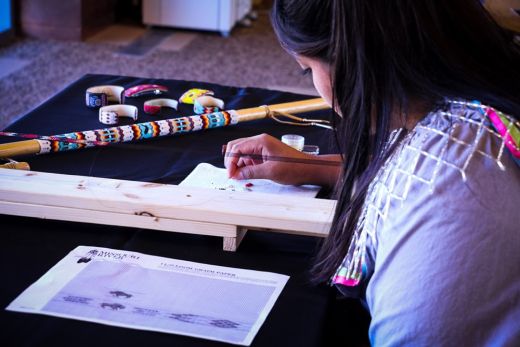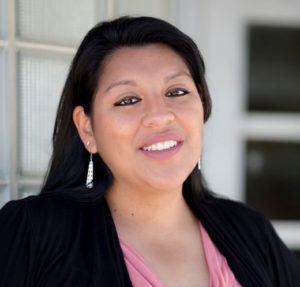
- Details
- By Chickasaw Nation Media
SULPHUR, Okla. — Few people can claim to have won in their age division not once, but twice at Oklahoma’s own Red Earth Festival. Courtney Parchcorn is one such artist. Known for her beadwork, she will be one of more than 100 Native Americans displaying her work at the ARTesian Arts Festival on May 23 in Sulphur, Oklahoma.
“I started doing beadwork with my dad when I was 13,” Parchcorn said. “He presented it to me as a challenge. As competitive as my family is, I started competing (at art shows) within the year. I am glad the ARTesian Arts Festival gives me another venue to both display and sell my work.”
Parchcorn appreciates the importance of sharing her Native American heritage. She can be found daily at the Chickasaw Cultural Center in Sulphur, sharing with others the things that make her happiest in life. Parchcorn is a cultural specialist, spending her time helping cultural center visitors better understand what it means to be Chickasaw.
 Courtney Parchcorn is an award-winning Chickasaw artist who shares her love of Native American bead craft with all who would like to learn the intricate art.
Courtney Parchcorn is an award-winning Chickasaw artist who shares her love of Native American bead craft with all who would like to learn the intricate art.
Having worked at the Chickasaw Cultural Center for nearly 10 years, she now demonstrates beadwork while visiting with patrons. She also participates in other culturally relevant activities such as stomp dance demonstrations. For the past few years, she has been giving “hands-on” beadwork classes to both Chickasaw Nation citizens and employees.
“I like sharing my culture and artwork with others,” she said. “It is a fun job and something I feel proud of doing. I have been doing it for a long time.”
Parchcorn is from Ada, Oklahoma. A citizen of the Chickasaw Nation, she also has Kiowa heritage. Her beadwork is influenced by tribes of the southeastern United States, as well as those from the plains.
While every project is important to Parchcorn, two stand out in her memory. These include the beadwork done on a walking cane for her grandfather and working closely with her father to bead shoes worn by Triana Browne-Hearrell, Miss Oklahoma USA 2019.
“I made the walking cane for my grandfather,” Parchcorn said. “He knew I was making it, but he thought it was for the Red Earth competition. He didn’t know I was actually making it for him. He passed away before I could give it to him. It is very special because of its sentimental value, and I won at Red Earth with it.
“I was also commissioned to do the beadwork for the Chickasaw Triana Brown-Hearrell shoes. They have both the great seals of the Chickasaw Nation and Oklahoma on them.”
Parchcorn says many life skills can be learned while beading. These include determination, perseverance and identifying one’s own shortcomings.
“The most important skill beadwork has taught me is patience,” she said. “It takes a lot of time to finish complicated projects. My friends say I have the patience of a saint, but they do not see the times when I have to push myself to work at my craft. This determination has transferred to other areas of life.”
Parchcorn continues to work closely with her father, Buddy. It is not uncommon for them to collaborate on beadwork designs. This collaboration not only produces beautiful one-of-a-kind items but also allows them to continue sharing new techniques they have each learned.
“I am always learning from others new ways of doing things. This is an art form that continues to grow as you do.”
Parchcorn is happy to be attending the 2020 ARTesian Arts Festival. She has participated in the past, both competing and having a booth where she sells her beadwork.
“The ARTesian Arts Festival is a lot of fun,” Parchcorn said. “I get to meet a lot of new artists, and people from across the nation look at my work. While I am at my booth, I am able to explain to buyers how things are made and how long it will take. The ARTesian Arts Festival allows me to sell existing pieces, as well and meet people who want me and my dad to do commissions.”
About the ARTesian Arts Festival
The Chickasaw Nation is hosting the 2020 Artesian Arts Festival, 10 a.m. to 6 p.m., Saturday, May 23, at the Artesian Plaza.
A celebration of all types of art, with an emphasis on Native American art and artists, the Artesian Arts Festival features diverse art media and a variety of visual art including paintings, basketry, jewelry, sculpture, metalworking, beadwork, textiles and pottery.
In 2019, the market saw more than 11,000 attendees and featured 125 elite Native American artists from 19 different tribes.
Open to the public at no charge, this family-friendly event features a variety of tribal dance demonstrations, artist talks, children’s activities, food vendors, live music performances and more.
Located adjacent to the Artesian Hotel and Spa, 1001 W. First St., Sulphur, the Artesian Plaza is only minutes from the Chickasaw Cultural Center. For more information, visit Chickasaw.net/Services/Other/Artesian-Arts-Festival or contact the Chickasaw Nation Arts & Humanities Division at (580) 272-5520 or [email protected].
More Stories Like This
Native News Weekly (August 25, 2024): D.C. BriefsUS Presidents in Their Own Words Concerning American Indians
Native News Weekly (December 14, 2025): D.C. Briefs
Wounded Knee Massacre Site Protection Bill Passes Congress
Two Murdered on Colville Indian Reservation
Help us defend tribal sovereignty.
At Native News Online, our mission is rooted in telling the stories that strengthen sovereignty and uplift Indigenous voices — not just at year’s end, but every single day.
Because of your generosity last year, we were able to keep our reporters on the ground in tribal communities, at national gatherings and in the halls of Congress — covering the issues that matter most to Indian Country: sovereignty, culture, education, health and economic opportunity.
That support sustained us through a tough year in 2025. Now, as we look to the year ahead, we need your help right now to ensure warrior journalism remains strong — reporting that defends tribal sovereignty, amplifies Native truth, and holds power accountable.
 The stakes couldn't be higher. Your support keeps Native voices heard, Native stories told and Native sovereignty defended.
The stakes couldn't be higher. Your support keeps Native voices heard, Native stories told and Native sovereignty defended.
Stand with Warrior Journalism today.
Levi Rickert (Potawatomi), Editor & Publisher
